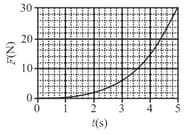HARD
Earn 100
A small spherical ball (obeying Stoke's law for viscous force) is thrown up vertically with a speed and is received back by the thrower at the point of projection with a speed . Neglecting the buoyant force on the ball, assuming the speed of the ball during its flight to be never equal to its terminal speed and taking the acceleration due to gravity , find the time of flight of the ball in seconds.
50% studentsanswered this correctly
Important Questions on Laws of Motion
EASY
HARD
MEDIUM
EASY
EASY
EASY
MEDIUM
MEDIUM
MEDIUM
EASY
EASY
HARD
MEDIUM
MEDIUM
HARD
MEDIUM
HARD
The graph below shows the variation of a force with time on a body which is moving in a straight line. Dependence of force on time is . Initially body is at rest.

If the speed of the object is at , then the speed at will be approximately (in )
MEDIUM
MEDIUM

